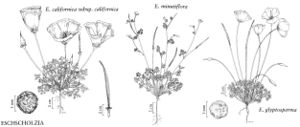Difference between revisions of "Eschscholzia glyptosperma"
Bull. Calif. Acad. Sci. 1: 70. 1885.
EndemicIllustrated
Treatment appears in FNA Volume 3.
imported>Volume Importer |
imported>Volume Importer |
||
| Line 53: | Line 53: | ||
|publication year=1885 | |publication year=1885 | ||
|special status=Endemic;Illustrated | |special status=Endemic;Illustrated | ||
| − | |source xml=https:// | + | |source xml=https://bitbucket.org/aafc-mbb/fna-data-curation/src/2e0870ddd59836b60bcf96646a41e87ea5a5943a/coarse_grained_fna_xml/V3/V3_254.xml |
|genus=Eschscholzia | |genus=Eschscholzia | ||
|species=Eschscholzia glyptosperma | |species=Eschscholzia glyptosperma | ||
Latest revision as of 21:47, 5 November 2020
Plants annual, scapose, erect, 5-25 cm, glabrous, sometimes glaucous. Leaves basal; blade with ultimate lobes acute. Inflorescences 1-flowered; buds nodding or sometimes erect. Flowers: receptacle conic, cup without spreading free rim; calyx acuminate, glabrous, sometimes glaucous; petals yellow, (10-)12-25 mm. Capsules 4-7 cm. Seeds tan to brown, spheric, 1.2-1.8 mm, minutely pitted. 2n = 14.
Phenology: Flowering spring (Mar–May).
Habitat: Desert washes, flats, slopes
Elevation: 50-1500 m
Distribution

Ariz., Calif., Nev., Utah.
Discussion
Eschscholzia glyptosperma is known from the Mojave and Sonoran deserts.
Selected References
None.
Lower Taxa
None.
